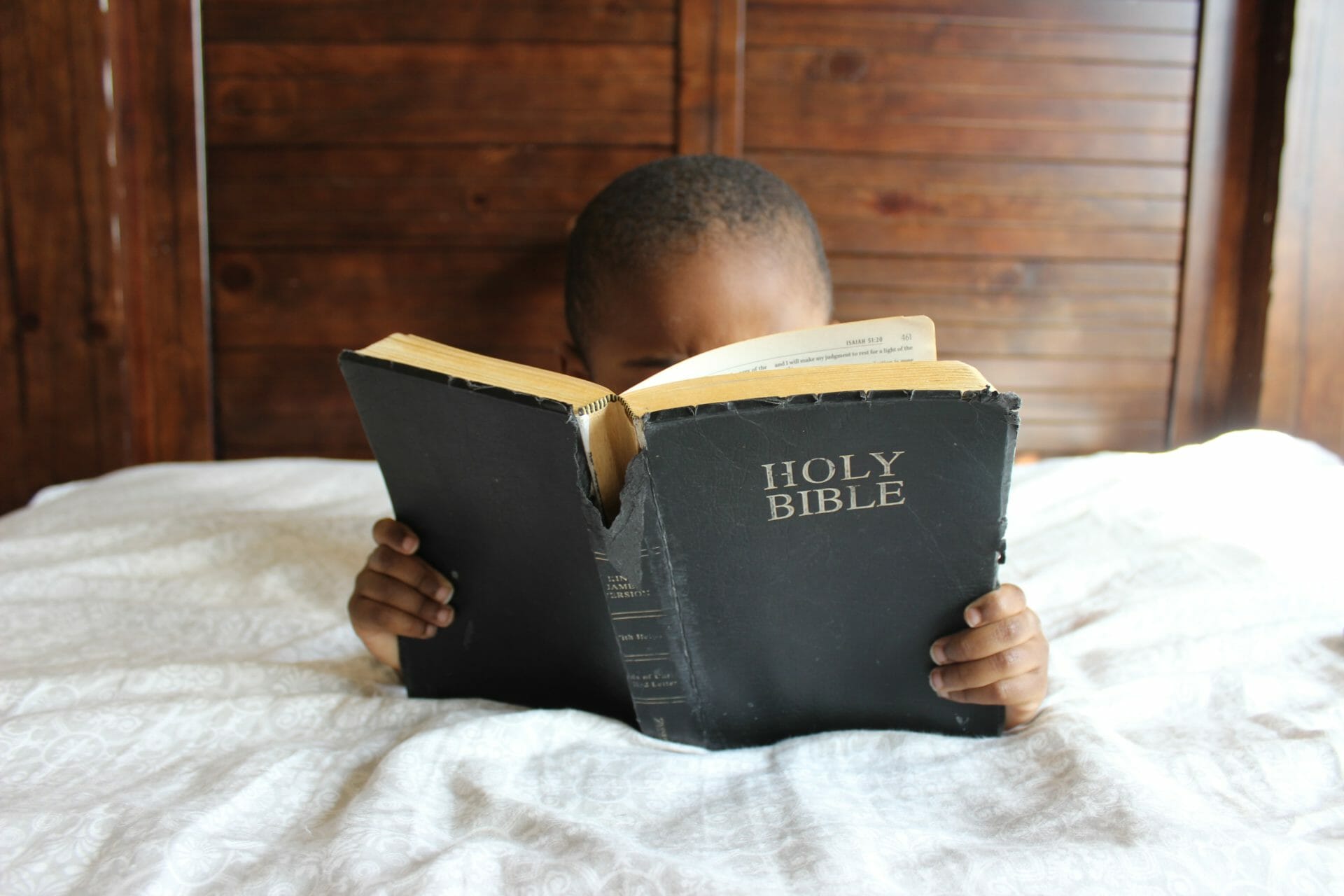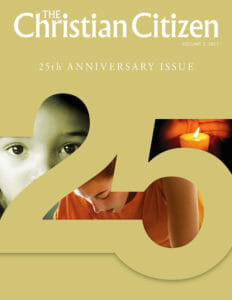
Photo by Samantha Sophia on Unsplash
To teach justice or maintain the status quo?
December 23, 2021
Editor’s note: This month, we are celebrating the 25th anniversary of The Christian Citizen by reprinting articles that previously appeared in print only or on an early version of our website. This article first published in Volume 2, 2013.
I recently had the opportunity to study hundreds of children’s Bibles and other children’s religious education materials from the 1700s and 1800s at the American Antiquarian Society and the Library of Congress. What I found was disturbing. While there were certainly some examples that promoted a faith concerned with freedom and justice, the vast majority adapted, changed, and moralized Bible stories in ways that worked to squelch any spirit of protest or advocacy for change. I probably should not have been surprised. Those who had the power and privilege to publish material were, whether they realized it or not, adapting the Bible in ways that maintained the status quo. When I returned home, I looked at more recent children’s Bibles and educational materials and discovered that we have not made much progress.
Throughout American history, the primary lesson of children’s religious education materials, in a wide variety of iterations, has been that if one is good, one will be rewarded; if one is bad or disobedient, one will be punished. Those of us who want to teach children that Christianity is a faith that calls us to work for justice have long-standing historical assumptions to overcome.
In the early American colonial period, the influence of Puritanism led to an emphasis on teaching children that they were depraved sinners in need of a healthy fear of God’s judgment. The Bible was primarily presented not as a repository of these doctrines but for its own sake. Bible catechisms and other materials were provided to help children memorize the Bible, along with hymnals and doctrinal catechisms. The primary goal was to immerse children in Christian devotion through the use of prayers, hymns, and Scripture.
In the late 1700s and early 1800s, during the time of the so-called Second Awakening, Bible stories were used as tools for conversion. The emphasis on the wickedness of rebellion and God’s judgment upon it supported the goal of leading children to repentance. Many children’s Bibles from the 1800s, for example, retell the story of the forty children of Bethel who were cursed and killed by two bears for mocking the prophet Elisha in ways that would instill fear into any child who might show disrespect for his or her elders. Retellings of the story of Noah’s ark inserted mocking neighbors not present in Genesis, suggesting to children that any kind of rebellious spirit was to be avoided.
In the mid-1800s, a number of abolitionist publications for children, such as “The Slave’s Friend,” were published for white children to encourage them to join the abolitionist cause. Most publishers of Sunday school materials, however, intentionally avoided the controversial subject. During this time a significant percentage of children of all races who came to the United States served as slaves and indentured servants. It may not be surprising, then, that the stories of the child Samuel and Naaman’s little maid were popular. In many children’s Bibles, these two children, who are taken from their homes and made to work, cheerfully and loyally serve their new masters. These adaptations taught children that they should work hard, be content with their lot in life and not complain.
Those who wish to teach children a faith that calls for civil rights, liberation and justice would do well to look through their children’s Bibles and Sunday school curriculum with a critical eye, asking “How are the Bible’s stories being used and what stories are included? Are we passing on a faith of justice and social action, or a faith of passivity and submission to a sometimes-unjust status quo?” Such questions might lead teachers and parents to adapt curricula, change how Bible stories are used with children, and include more Bible stories that call children, and call us all, to become actively faithful and just Christian citizens.
During the mid-to-late-1800s, with a dawning sentimental and romantic view of children, many religious education materials told contemporary stories of sweet and gentle children who gladly gave their lives in order to serve their parents or others in authority. The biblical stories of the sacrifices of the boy Isaac and Jephthah’s daughter were quite popular in children’s Bibles of this time, with retellings that portrayed Isaac and Jephthah’s daughter as completely submissive, gladly giving their lives for the sake of their parents without any thought of their own needs.
 During the Industrial Revolution, at the end of the 1800s and into the early part of the 1900s, many white, Protestant Christians voiced fears that they could no longer trust immigrants or freed slaves to teach their children the virtues necessary to make them compliant workers.
During the Industrial Revolution, at the end of the 1800s and into the early part of the 1900s, many white, Protestant Christians voiced fears that they could no longer trust immigrants or freed slaves to teach their children the virtues necessary to make them compliant workers.
Protestant Christians took up the agenda of teaching children citizenry virtues such as working hard and not complaining. In some of these children’s Bibles, Noah is lifted up as a role model for hard work. A few children’s Bibles even suggested that the reason God chose Noah to be spared is because God knew Noah was a hard worker. While the Bible does not contain many details on the childhood of Jesus, children’s Bibles have added stories and anecdotes that present the child Jesus as cheerfully and quickly obeying his parents whenever asked to do any task. These stories also imply or state explicitly that if Jesus himself was content with his station in life as a poor child then all children should accept their place.
In the mid-twentieth century, large single-volume or multi-volume children’s Bibles became increasingly popular. Images in these volumes affirm loyalty to God and country—a reflection of the national emphasis on the U.S. as a God-fearing nation in contrast to nations on the other side of the Iron Curtain. While the 1960s and ’70s saw some lessons of social justice entering religious education materials, the 1980s brought (perhaps in reaction) a strong affirmation of family values along with a return to non-rebellious citizenry values such as obedience, submission and hard work.
The last few decades have brought an increase of children’s Bibles as fun, benign children’s storybooks with anthropomorphic animal friends and smiling faces. In some cases, young children are encouraged to hug children’s Bibles that are covered with soft fuzzy material, which literally transforms the Bible into a warm, fuzzy feeling. The messages implied by these versions of Bible stories are consistent with what sociologist Christian Smith calls “Moral Therapeutic Deism,” in which human agency is played down and God is often seen as taking care of children to the point that there is no need for any person to act. The story of Nathan the prophet speaking truth to power, for example, is rarely included in children’s Bibles. In retelling the story of baby Moses, authors sometimes portray God providentially directing Moses’ floating basket down the river to Pharaoh’s daughter, rather than speaking of the clever and subversive act of Moses’ mother and sister. Also missing are stories of the just and subversive disobedience of the Hebrew midwives who saved the Hebrew baby boys (Exodus 1:15-17).
Those who wish to teach children a faith that calls for civil rights, liberation and justice would do well to look through their children’s Bibles and Sunday school curriculum with a critical eye, asking “How are the Bible’s stories being used and what stories are included? Are we passing on a faith of justice and social action, or a faith of passivity and submission to a sometimes-unjust status quo?” Such questions might lead teachers and parents to adapt curricula, change how Bible stories are used with children, and include more Bible stories that call children, and call us all, to become actively faithful and just Christian citizens.
Rev. Dr. Russell W. Dalton is an ordained American Baptist minister and Professor of Religious Education at Brite Divinity School, Texas Christian University, Fort Worth, Texas. At time of writing, he was professor of Christian Education at Brite.
The views expressed are those of the author and not necessarily those of American Baptist Home Mission Societies.


